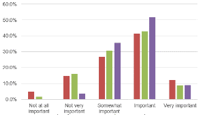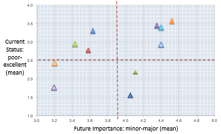It’s Time for the Annual Membership Survey—Then What?
To prevent this wasteful cycle from happening in your organization, be clear from the outset about two things: 1) why you are undertaking a membership survey and 2) what you expect to do with the results.
Here are five ways membership surveys can add value:

1) Tracking Overall Loyalty: Net Promoter Score
In searching for a simple management tool that could easily be tracked and correlated with revenue, Bain and Company developed the “Net Promoter Score.” NPS is based on a single question: likelihood to recommend the company, product or service. Using an 11-point scale (0 through 10) results are grouped to counteract the positive skew that typically occurs when measuring satisfaction. Scores of 0 – 6 are labeled “detractors;” 7 and 8 are “passive;” and 9 and 10 are “promoters.” The resulting NPS equals promoters minus detractors.
NPS is designed to provide a bottom-line sense of whether an organization is going in the right direction. To be most valuable, measurement should occur frequently enough to establish a stable trend and detect any changes. Therefore, an organization might consider altering the survey frequency from an annual to quarterly basis with the total membership being divided into four randomly chosen segments, each receiving the survey once a year on a rotating basis.

2) Measuring Satisfaction: Current Programs
The most common use of a membership survey is to measure satisfaction. Respondents are provided an array of current programs, services and functions and asked to rate their satisfaction with each one. When designing the survey, it will likely make sense to include:
- Items from previous years mostly related to core strategic objectives
- Additional probes for items which have undergone change or improvement efforts; and
- New products or services that have been developed since the last time the survey was administered.
Analyzing satisfaction scores and determining resulting action steps is often facilitated by focusing on relative satisfaction rather than just absolute scores. For example, what items are in the top quartile of satisfaction versus subsequent quartiles? How has satisfaction with each item changed from previous measurements?

3) Measuring Importance: Adding value
Of course, satisfaction is only one side of the coin. You also want to know what is important to the respondents. Focusing on importance—the extent to which a product or service adds to the member’s perceptions of value—also allows for assessing potential future initiatives. While asking about something that exists can be relatively straight forward, assessing potential initiatives is trickier.
Surveys generally are designed to measure perceptions. However, when respondents are asked behavioral intent questions (e.g., would you buy …) responses are notoriously unreliable. For that reason, it is often better to ask about perceptions of attributes of a potential new product rather than the product itself. And, as with satisfaction, analyzing the relative importance of a group of items can often be more helpful than focusing on absolute scores.

4) Establishing Priorities
One of the advantages of measuring both satisfaction with current products and services as well as perceptions about the future importance of those same items, is that the pieces can be put together to help identify initiatives that will add member value. A simple 2×2 chart creates four sectors: low satisfaction-low importance; low satisfaction-high importance; high satisfaction-low importance; and high satisfaction-high importance.
Each of the four quadrants implies a different set of actions. Clearly items with low satisfaction and high importance are critical for further investigation and improvement. On the other hand, items with high satisfaction but low importance may be taking up more organizational resources and effort than needed relative to other priorities. Items with low satisfaction but also with low importance might not need significant attention—and perhaps some might be discontinued from the organization’s portfolio. Those items with high satisfaction and high importance should be monitored to avoid any deterioration. Such items may also point to potential new product or service initiatives with related attributes that will add significant customer value.

5) Understanding/Developing Personas
A membership survey also can help develop target market segments by identifying factors that are important to subgroups of the membership. For some associations, the annual meeting is the major revenue producer. A core of the membership attends every year and looks forward to networking and catching up with colleagues. For that segment, which focuses on social interactions at the annual meeting, nothing else the association does matters. By itself, it is sufficient to assure continued membership. However, associations run significant risk if they do not recognize that the annual meeting loyalists are only one segment, and that other members are looking for value in a variety of other ways.
By profiling members in terms of the types of products, services and interactions they find beneficial, a membership survey can contribute to defining prototypical membership profiles, or personas, around which program development can occur. In the process, the organization may find that traditional approaches to segmentation based on demographic factors are insufficient and need to be supplemented with segments that are defined by variations in member expectations and motivations for joining.
With a clear sense of the strategic reasons for undertaking a membership survey, the survey development process will be more focused and the analysis more useful. Remember: a membership survey is only one aspect of a customer feedback system. It is also important to design mechanisms to obtain feedback from non-member customers. The same principles for members apply to non-member customers, although the range of topics may differ.

